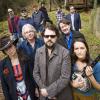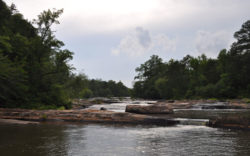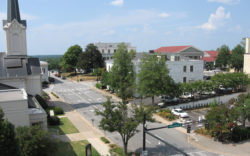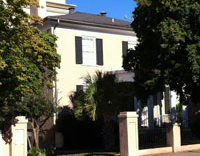Jane Jacobs’ seminal work, The Death and Life of Great American Cities, just turned 50 a few months back, and while the occasion went unmarked in this column at the time, recent events have gotten me thinking about how her ideas have been carried forward over time, and ultimately corrupted. It’s been a slow progression over the last half-century, as her observational urbanism was adapted into the more codified New Urbanism and Smart Growth approaches, which ultimately have become mere marketing tools. It’s the planning equivalent of “greenwashing,†where questionable sustainability claims are used to sell products that are inherently unsustainable.
While Selig and the gang would have us believe that their shopping center is an extension of downtown, an urban project utilizing New Urbanist thinking to fit in and embrace the city, pointing to a few mixed-use buildings as evidence, this is not the case. Even the Mall of Georgia, quintessentially opposite to the Main Street model of commerce, has a little “downtown†wedged between the parking lots and the big box. “Lifestyle centersâ€â€”a euphemism for this sort of artificial Main Street—had been picking up as a New-Urbanist skin on the American shopping mall. However, it’s the underlying dynamic, more than the architecture, that defines the way a place will actually function. Make no mistake, Selig is building a lifestyle-center shopping mall on the outskirts of downtown.
The kernel that Jacobs and other early documenters of urban life really focused on was the nearly ecological nature of cities, with an orderly chaos of intricate interactions among diverse webs of interlocking factors. While mixed-use buildings are a manifestation and a potential indicator of a dynamic urban neighborhood, they are not equivalent to one, in the same way that simply because one plants oak trees in their yard, they have not actually created a living forest ecosystem.
Whether Selig spends 80 million or 800 million on that site, they won’t create a real neighborhood, only a shopping center. You can’t build neighborhoods from the ground up; they must be grown, organically over time, in the same way that you can’t construct a living tree, no matter how much money you spend on it. Two-by-fours nailed back together do not recombine into a pine tree. What we can do is prepare the soil, so that when the right seeds fall, they grow rather than wither.
Until one understands why community is so precious and rare, it’s really hard to see the value of it. It’s the distinction between building and growing that people like Selig and Athens Banner-Herald editorial page editor Jim Thompson so completely fail to grasp. Interestingly, both have mistaken the raw matter of historic landmarks in the area for the complex ideas that they embody. Thompson continually suggests chopping up local landmarks and selling them off as paperweights—including the St. Mary’s Episcopal Steeple and, most recently, the Georgia Railroad Trestle in Dudley Park—as if this were somehow equivalent to preserving them or relevant to the community’s valuation of them. Likewise, Selig has suggested that reuse of bricks from the National Register historic buildings they intend to demolish is somehow a useful idea. But old bricks are simply clay, with no memory of what they used to be: ashes to ashes, dust to dust, as it were. If these places are not part of the living meta-organism that is a community, they are simply raw matter.
Jacobs’ and the New Urbanists’ most compelling ideas were based on creating a framework for future growth and evolution, the “good soil†in which community can grow. Our local framework has been undergoing the death of a thousand cuts, as essential streets and connections which contribute to the health of the system are slowly whittled away. Similarly to ecology, though, “shifting baseline syndrome†is a big issue, and memory of what was doesn’t go back far enough. And so, we continually accept more and more impaired iterations of what was originally vibrant.
If we’re going to move from meeting each crisis with mild appeasement and mitigating each individual loss to actually growing our community economically and culturally, we have to look at what makes a successful and dynamic urban framework, actually prioritize it rather than paying it lip service, and then enforce those priorities. Those priorities should include a seamless, multi-modal connectivity, with good streets and plenty of redundancy in connections. Overlaying that are the linked issues of scale, density and age. Dynamic urban environments are determined to a great degree by the plats and property lines which originally established them. Those narrow lots and a complex ownership landscape ultimately do an excellent job of regulating height, use and density, and allow for the kind of diversity in age and cost that Jacobs documented 50 years ago. Selig has the opportunity to create a similar vibrancy by incorporating some of the historic structures on the site; unfortunately, as builders of shopping centers, this is a foreign notion to them.
Even the once-mighty Sears, Roebuck and Co. has now lost its hegemony, and so too will Walmart. Whether they occupy this development for 10 or 30 or 50 years, one day they won’t, and what happens then? City Hall East, the massive Sears warehouse in Atlanta, was underutilized for decades, awaiting the right redevelopment scheme. Selig is building its own version. The Banner-Herald’s state-of-the-art building was likewise out of date as soon as it was finished, and never fully occupied. It took 20 years for debt-ridden Morris Publishing to finally recognize and unload that albatross. It remains to be seen whether their respective new owners will be able to adapt these out-of-scale structures to new life; however, the solution will almost certainly involve decentralization, breaking them up into smaller and more flexible pieces.
Everything is changing constantly, and whether this city will evolve as successfully as its namesake has over the millennia depends on whether or not we can plan a truly adaptable framework. The city is a living place, and we must start thinking and working within an ecological rather than a simply architectural paradigm if we want it to grow. It’s a deceptively simple idea.
Like what you just read? Support Flagpole by making a donation today. Every dollar you give helps fund our ongoing mission to provide Athens with quality, independent journalism.










